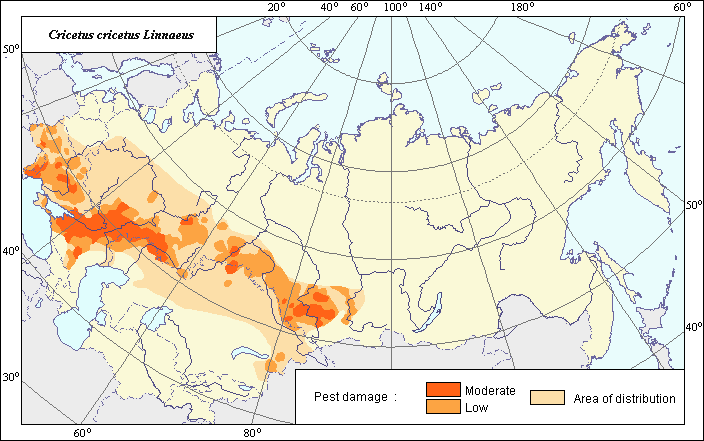Pests
Area of distribution and harmfulness of Common Hamster (Cricetus cricetus L.)
 Object description Download GIS-layers
Object description Download GIS-layers
Authors:
Object specialist - F.A. Karlik, GIS-specialist - M.I. Saulich.Date of creation:
27.01.2004.Scale:
1:20 000 000.Accuracy of map:
Map was created based on materials of maps of natural scale 1:15 000 000-1:100 000 000 and literature data.Projection:
"Alber.s Equal Conica for the USSR", 9, 1001, 7, 100, 0, 44, 68, 0, 0.Basic contents:
Vector map of three thematic layers. Area of species distribution is shown by polygons. Zones of recorded mass outbreak are shown by polygons.Accuracy of classifier:
Within the area of distribution two zones of harmfulness are established. In the zone of low damage the colonization of arable lands is not more than 10 inhabited burrows per 1 hectare. The zone of moderate damage is characterized by the colonization of arable lands with density of more than 10 inhabited burrows per 1 hectare to a maximum of 50 or more inhabited burrows per 1 hectare in foci; in years with optimal conditions for the species activity.Method of map production:
Two original maps of areas of the Common Hamster (Bobrinsky et al., 1965 & Flint et al., 1970) have been used for the creation of the area of its distribution. The limits of the area of the pest in the territory of Russia are adjusted according to Pavlinov et al. (2002). The configuration of pest damage zones has been determined taking into account a map composed from data about the Common Hamster which characterized the occurence frequency of this species in different parts of the area over 10 years (Neronov & Tupikova, 1966; Nechay et al., 1977). The map was scanned. Registration and vectoring of raster maps were executed by standard facilities of GIS-technologies. A correction of pest damage zones was made according to the vector layer of the Map of Arable Lands distribution (Koroljeva et al., 2003).Reference citations:
Bobrinsky N.A., Kuznetsov B.A., Kuzyakin A.P. 1965. Keys to Mammals of the USSR. Editor, A.P. Kuzyakin. Moscow: Prosveshchenie. 382 p. (In Russian)Flint V.E., Chugunov Yu.D., Smirin V.M. 1970. Mammals of the USSR. Editor, A.N. Formozov. Moscow: Mysl. 437 p. (In Russian)
Koroljeva IE, Vilchevskaya EV, Ruhovich DI. 2003. Digital Arable Land Map. Laboratory of Soil Information of the Dokuchaev Soil Institute, Moscow, Russia [Based on: Yanvareva LF. (ed.), Martynjuk KN., Kisileva NM. 1989. Map of Land Use, Faculty of Geography, Moscow State University, Moscow, Russia.].
Nechay G., Hamar M., Grulich I. 1977. The Common Hamster (Cricetus cricetus (L.)): a Review. European and Mediterranean Plant Protection Organization (EPPO) Bulletin, 7(2): 255-276.
Neronov V.M., Tupikova N.V. 1967. Regional stocks of purchased fells as index of animal population (by the example of Common Hamster). In: Editor, A.N. Formozov. Fauna i ekologiya gryzunov. Issue 8. Moscow: Moscow University. 188-196 p. (In Russian)
Pavlinov I.Ya., Kruskop S.V., Varshavskii A.A., Borisenko A.V. 2002. Terrestrial animals of Russia. In: Editors, E.A. Dunaev, K.G. Mikhailov. Manual-Identification book. Moscow: KMK. 298 p. (In Russian)
Right and copyright:
All rights reserved. Copyright 2004© F.A. Karlik & M.I. Saulich.Picture of Cricetus cricetus was taken from book by Bobrinsky N.A., Kuznetsov B.A., Kuzyakin A.P. 1965. "Keys to Mammals of the USSR".

